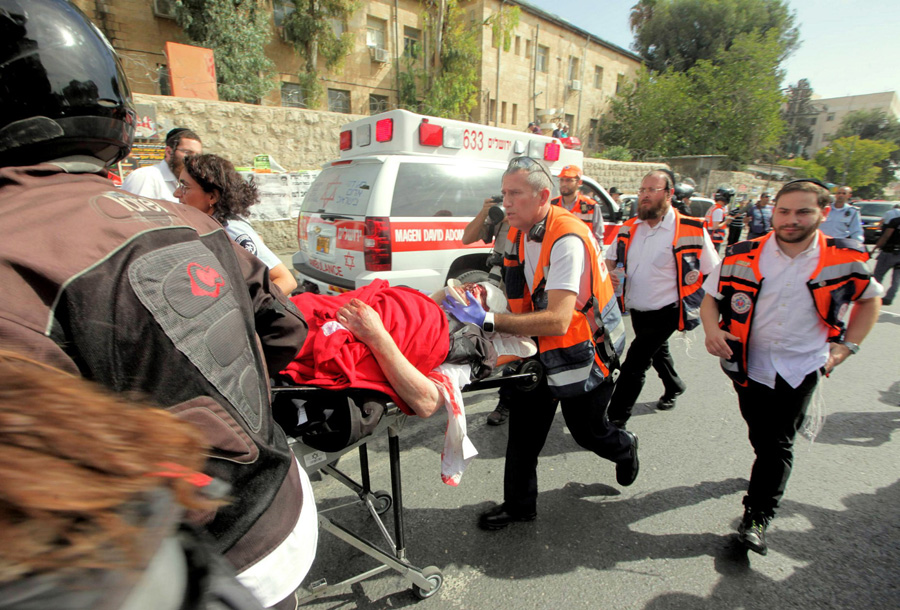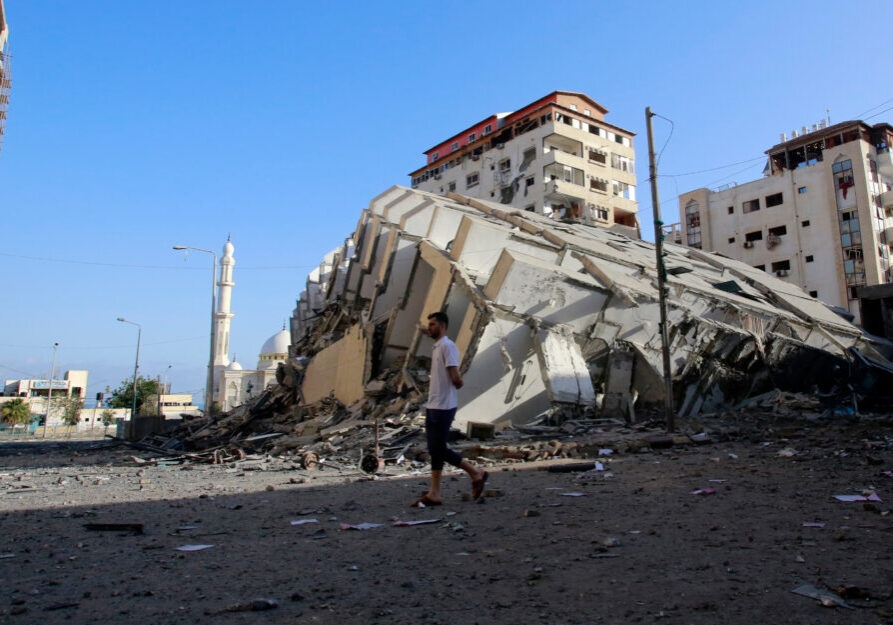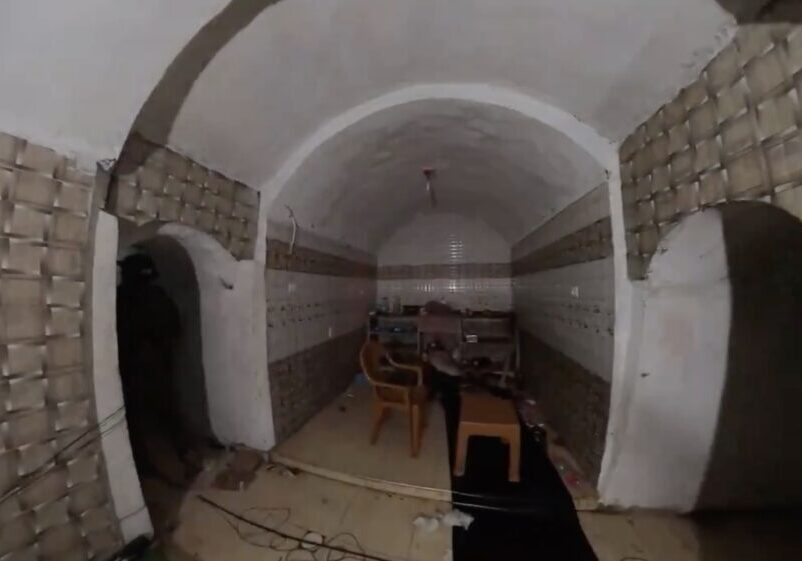Australia/Israel Review
“Lone Wolves” for Al-Aqsa
Oct 28, 2015 | Amotz Asa-El

Amotz Asa-El
Eitam and Naama Henkin were driving in the West Bank northeast of Tel-Aviv when bullets sprayed from a passing car took the couple’s lives and orphaned their four boys, ages nine years to eight months, who witnessed their parents’ murders from the car’s back seat.
The five assailants were quickly arrested after the IDF found a pistol they lost at the scene. The couple, she a graphic designer and he a rabbi and historian, soon emerged as among the first victims of the most intense spate of terror attacks Israel has faced in more than a decade.
Israeli civilians, policemen and soldiers faced 14 stabbing assaults during October’s first 18 days, mostly in east Jerusalem, but also in Tel Aviv and Raanana in the coastal plain, Kiryat Gat in the south, Afula in the north, and Hebron in the West Bank.
None of the assailants managed to flee. Confronted by passers-by or patrolling troops, they were either injured or killed.
In addition to these and the slaying of the Henkin couple, there was an apparent attempt to detonate a car bomb east of Jerusalem, foiled by an alert policeman, and a shooting attack on a bus in the Jerusalem neighbourhood of Armon Hanatziv. One attack involved a man emerging from his car with a knife after he had just rammed it into people waiting at a bus stop to try to kill as many more random civilians as possible.
Ten Israelis and 40 Palestinians have died in this outburst, as of October 21.
The General Security Service has yet to detect an organising arm behind the wave of attacks, which the Palestinians claim is spontaneous. Some analysts believe that the frequency of the attacks and the stabbers’ young ages, including teenagers and minors, indicate that someone is recruiting, paying and deploying a particular type of attacker in order to create a particular type of impression. Others believe that unlike previous terror waves Israel faced, this one has no central organiser, and will therefore require a response that has yet to be devised.
Meanwhile, the stabbing attacks have been interspersed with disturbances in various places in the Gaza Strip, the West Bank, and on Oct. 7 also in Jaffa, where some Arab rioters were quickly dispersed after throwing stones at buses.
The following day, an Israeli mob stormed several Arab passers-by in the resort town of Netanya, and two days before that an Israeli terrorist stabbed four Arab workers in a construction site in the southern town of Dimona.
Having said this, disturbances in Palestinian towns have so far been relatively poorly attended, and largely quelled quickly by the IDF, which over the years has improved its know-how in riot dispersal and crowd control. As of now, this wave is mostly about individuals attacking pedestrians, usually with knives – it thus bears little resemblance to either the mass demonstrations or terror by organised groups, which characterised the first and second intifadas.
As the government tries to gather more facts so it can prepare a longer-term response, it has taken several emergency measures and at the same time emerged with its own analysis concerning the root of the violence.
The first thing the government ordered was a dramatic increase in the police presence on the streets, particularly of Jerusalem. Thousands of cops, Border Police and IDF soldiers were enlisted for reserve duty and deployed along urban arteries and in hundreds of central locations throughout the country.
The efficiency of this measure was made plain several days on, when a jogger in Jerusalem saw a suspicious man and alerted a Border Police squad which was just down the street thanks to the special deployment. A policeman approached the suspicious man who indeed pulled out a knife and was summarily shot dead.
The security forces’ special deployment also includes newly positioned checkpoints outside Palestinian neighbourhoods in east Jerusalem, from which most of the stabbers have emerged.
On the political level, the government is considering outlawing the northern faction of the Islamic Movement, an Israel-based Islamist organisation that it sees as a major inspiration and mastermind of the religiously inspired violence it has come to face.
While the efficacy of these measures can only be judged over time, their effect for now is twofold: on the one hand, it increases the public’s confidence, but on the other hand it highlights east Jerusalem’s unique, and explosive, status as a political no-man’s land.
While they carry Israeli IDs and constitute 36% of Jerusalem’s 830,000 residents, Arab Jerusalemites mostly don’t see themselves as Israelis, have few social ties with their Jewish neighbours, and have been suspicious of municipal attempts to develop their neighbourhoods. At the same time, and unlike the surrounding West Bank, east Jerusalem is not part of the Palestinian Authority’s jurisdiction. The result is urban negligence and political estrangement.
Jerusalemite terrorists have so far been the current mayhem’s spearhead, but why Arab Jerusalemites are suddenly producing such violence is a matter of interpretation.
The Palestinians ascribe their wrath to what they portray as “the threat” to Jerusalem’s silver-domed Al-Aqsa Mosque and the golden-domed Shrine of Omar.
Located atop the Temple Mount, the site of the ancient Jewish temples, just beyond the famous Western Wall, Israel accepts the Mosques as exclusively Muslim worship sites. Like all non-Muslims, Israelis are allowed to visit the Mount, but not to pray. Moreover, Jewish religious law has forbidden Jews since antiquity to even set foot on the compound until the Messiah arrives, a ban that has been upheld by most rabbis, including Israel’s Chief Rabbinate.
Even so, in recent years various religious fringe groups, including some politicians, have ignored the rabbinic prohibition and begun visiting the compound with growing frequency. Some also tried to symbolically say some words of prayer while within the compound, with the aim of protesting the Israeli prohibition on Jewish worship in Judaism’s holiest site.
These marginal groups’ acts notwithstanding, the compound’s 48-year status-quo has been preserved. Even so, Palestinian fundamentalists, led by the northern faction of the Islamic Movement, have been for years spreading accusations that the Israeli government plans to destroy the mosques and rebuild in their place a Jewish temple. Their audiences believe them.
Inspired by these claims, on September 10, the Thursday before the Jewish New Year’s weekend, hundreds of Palestinians stayed the night in the Al-Aqsa Mosque where they gathered stones, bats, bars and explosives for a clash they intended to provoke with police, while thousands of Jews crowded at the nearby Western Wall for the holiday prayers. Police entered the Temple Mount compound to search for explosives – which they indeed found. Clashes soon followed.
The violence on Temple Mount radiated. Stones thrown at the car of a 64-year-old Israeli driver on his way to a New Year’s meal with his family caused him to fatally crash his car into a lamppost.
Meanwhile, the unrest surrounding Temple Mount fanned yet more incitement, soon joined by the Jordanian government – which Israel accepts as responsible for the mosques’ custodianship.
Even so, whether the Temple Mount events are the current mayhem’s root or pretext remains unclear. Terror attacks have been waged sporadically since before last year’s skirmish in Gaza.
However, while most Israelis dismiss as baseless the Islamist charges concerning Israel’s designs against Al-Aqsa, all agree that what is happening now has a major religious element.
Prime Minister Binyamin Netanyahu has stated publicly and plainly that Israel intends to uphold the status-quo on the Temple Mount. Moreover, most Israelis are secularists who are perfectly happy with the mosques’ current arrangement, and most religious Israelis unequivocally accept the religious ban on entering the compound.
As Netanyahu sees it, the religious fervour that is at play in this cycle of violence is manufactured, fueled by cynically premeditated incitement.
The incitement charge is aimed not only at Hamas and Islamist circles on both sides of the Green Line, but also at the nominally secular Palestinian Authority, and with it at President Mahmoud Abbas personally.
Abbas outraged Israelis twice: First, when he said in a videotaped address that Israelis were “defiling Temple Mount with their filthy feet,” and then when he charged in a televised statement that Israel “executed” a Palestinian boy who stabbed and critically injured an Israeli boy.
The stabber, Ahmed Mansara, 13, together with his 16-year-old cousin, attacked an Israeli boy, also 13, while the latter was riding his bicycle outside a candy store in the east-Jerusalem neighbourhood of Pisgat Zeev. The attack was caught on video cameras. Moreover, contrary to Abbas’ claims, Mansara, who was hit by a car while fleeing police, is alive and being treated at Hadassah Ein Kerem Hospital.
Noting that Abbas first “propagated the falsehood that helped trigger the violence” and then invented a living boy’s execution, the Washington Post wrote that the Palestinian leader has become “irrelevant.”
This is the backdrop against which Israel’s main diplomatic response to the situation is a demand that Abbas and the PA immediately cease all incitement. Netanyahu also said he would like to meet with Abbas and discuss the situation, a prospect that for now seems unlikely.
In fact, chances for effective diplomatic action are low, even as US Secretary of State John Kerry and UN Secretary-General Ban Ki-Moon are expected in Jerusalem and Ramallah. A French proposal to position foreign observers on Temple Mount was angrily dismissed by Israel and is universally seen as a rhetorical non-starter.
Other relevant actors, from Moscow through Brussels, London, and Berlin to Cairo and Riyadh, are too busy concentrating on much larger fires elsewhere in the Middle East.
With Russian fighter-jets attacking Islamist rebels in Syria and Saudi bombers pounding Iranian-backed insurgents in Yemen, while Egyptian brigades confront Islamists in the Sinai and an increasingly unpopular Islamist government brews strife in Turkey – what Israel now faces appears but a detail. Overall, there is a much broader picture of massive regional tremors driven by religious zeal and underscored by dramatic migratory pressure on Europe.
Israel is neither the cause of, nor in a position to undo, the surge of Islamism across the Middle East. It is, however, tasked with confronting and containing its own small portion of its wrath.
This article is featured in this month’s Australia/Israel Review, which can be downloaded as a free App: see here for more details.
Tags: Israel






